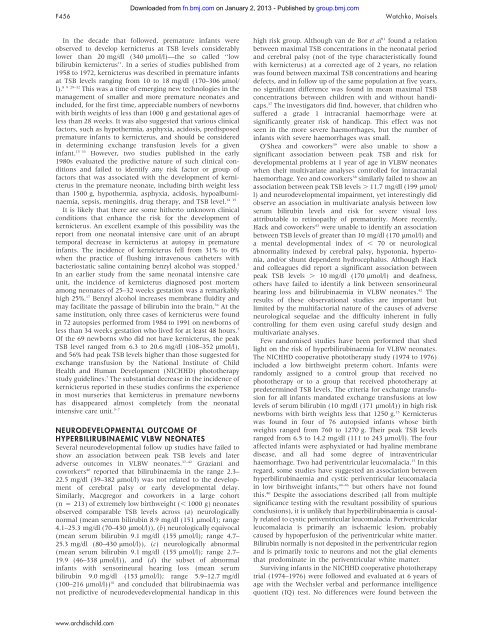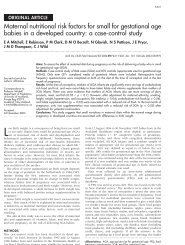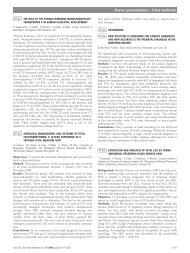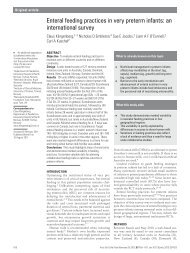Jaundice in low birthweight infants - Fetal and Neonatal Edition - BMJ
Jaundice in low birthweight infants - Fetal and Neonatal Edition - BMJ
Jaundice in low birthweight infants - Fetal and Neonatal Edition - BMJ
You also want an ePaper? Increase the reach of your titles
YUMPU automatically turns print PDFs into web optimized ePapers that Google loves.
Downloaded from<br />
fn.bmj.com on January 2, 2013 - Published by group.bmj.com<br />
F456 Watchko, Maisels<br />
In the decade that fol<strong>low</strong>ed, premature <strong>in</strong>fants were<br />
observed to develop kernicterus at TSB levels considerably<br />
<strong>low</strong>er than 20 mg/dl (340 mmol/l)—the so called ‘‘<strong>low</strong><br />
bilirub<strong>in</strong> kernicterus’’. In a series of studies published from<br />
1958 to 1972, kernicterus was described <strong>in</strong> premature <strong>in</strong>fants<br />
at TSB levels rang<strong>in</strong>g from 10 to 18 mg/dl (170–306 mmol/<br />
l). 8 9 29–32 This was a time of emerg<strong>in</strong>g new technologies <strong>in</strong> the<br />
management of smaller <strong>and</strong> more premature neonates <strong>and</strong><br />
<strong>in</strong>cluded, for the first time, appreciable numbers of newborns<br />
with birth weights of less than 1000 g <strong>and</strong> gestational ages of<br />
less than 28 weeks. It was also suggested that various cl<strong>in</strong>ical<br />
factors, such as hypothermia, asphyxia, acidosis, predisposed<br />
premature <strong>in</strong>fants to kernicterus, <strong>and</strong> should be considered<br />
<strong>in</strong> determ<strong>in</strong><strong>in</strong>g exchange transfusion levels for a given<br />
<strong>in</strong>fant. 15 33 However, two studies published <strong>in</strong> the early<br />
1980s evaluated the predictive nature of such cl<strong>in</strong>ical conditions<br />
<strong>and</strong> failed to identify any risk factor or group of<br />
factors that was associated with the development of kernicterus<br />
<strong>in</strong> the premature neonate, <strong>in</strong>clud<strong>in</strong>g birth weight less<br />
than 1500 g, hypothermia, asphyxia, acidosis, hypoalbumi-<br />
naemia, sepsis, men<strong>in</strong>gitis, drug therapy, <strong>and</strong> TSB level.<br />
34 35<br />
It is likely that there are some hitherto unknown cl<strong>in</strong>ical<br />
conditions that enhance the risk for the development of<br />
kernicterus. An excellent example of this possibility was the<br />
report from one neonatal <strong>in</strong>tensive care unit of an abrupt<br />
temporal decrease <strong>in</strong> kernicterus at autopsy <strong>in</strong> premature<br />
<strong>in</strong>fants. The <strong>in</strong>cidence of kernicterus fell from 31% to 0%<br />
when the practice of flush<strong>in</strong>g <strong>in</strong>travenous catheters with<br />
bacteriostatic sal<strong>in</strong>e conta<strong>in</strong><strong>in</strong>g benzyl alcohol was stopped. 5<br />
In an earlier study from the same neonatal <strong>in</strong>tensive care<br />
unit, the <strong>in</strong>cidence of kernicterus diagnosed post mortem<br />
among neonates of 25–32 weeks gestation was a remarkably<br />
high 25%. 17 Benzyl alcohol <strong>in</strong>creases membrane fluidity <strong>and</strong><br />
may facilitate the passage of bilirub<strong>in</strong> <strong>in</strong>to the bra<strong>in</strong>. 36 At the<br />
same <strong>in</strong>stitution, only three cases of kernicterus were found<br />
<strong>in</strong> 72 autopsies performed from 1984 to 1991 on newborns of<br />
less than 34 weeks gestation who lived for at least 48 hours. 7<br />
Of the 69 newborns who did not have kernicterus, the peak<br />
TSB level ranged from 6.3 to 20.6 mg/dl (108–352 mmol/l),<br />
<strong>and</strong> 56% had peak TSB levels higher than those suggested for<br />
exchange transfusion by the National Institute of Child<br />
Health <strong>and</strong> Human Development (NICHHD) phototherapy<br />
study guidel<strong>in</strong>es. 7 The substantial decrease <strong>in</strong> the <strong>in</strong>cidence of<br />
kernicterus reported <strong>in</strong> these studies confirms the experience<br />
<strong>in</strong> most nurseries that kernicterus <strong>in</strong> premature newborns<br />
has disappeared almost completely from the neonatal<br />
<strong>in</strong>tensive care unit. 5–7<br />
NEURODEVELOPMENTAL OUTCOME OF<br />
HYPERBILIRUBINAEMIC VLBW NEONATES<br />
Several neurodevelopmental fol<strong>low</strong> up studies have failed to<br />
show an association between peak TSB levels <strong>and</strong> later<br />
adverse outcomes <strong>in</strong> VLBW neonates. 37–42 Graziani <strong>and</strong><br />
coworkers 40 reported that bilirub<strong>in</strong>aemia <strong>in</strong> the range 2.3–<br />
22.5 mg/dl (39–382 mmol/l) was not related to the development<br />
of cerebral palsy or early developmental delay.<br />
Similarly, Macgregor <strong>and</strong> coworkers <strong>in</strong> a large cohort<br />
(n = 213) of extremely <strong>low</strong> <strong>birthweight</strong> (, 1000 g) neonates<br />
observed comparable TSB levels across (a) neurologically<br />
normal (mean serum bilirub<strong>in</strong> 8.9 mg/dl (151 mmol/l); range<br />
4.1–25.3 mg/dl (70–430 mmol/l)), (b) neurologically equivocal<br />
(mean serum bilirub<strong>in</strong> 9.1 mg/dl (155 mmol/l); range 4.7–<br />
25.3 mg/dl (80–430 mmol/l)), (c) neurologically abnormal<br />
(mean serum bilirub<strong>in</strong> 9.1 mg/dl (155 mmol/l); range 2.7–<br />
19.9 (46–338 mmol/l)), <strong>and</strong> (d) the subset of abnormal<br />
<strong>in</strong>fants with sensor<strong>in</strong>eural hear<strong>in</strong>g loss (mean serum<br />
bilirub<strong>in</strong> 9.0 mg/dl (153 mmol/l); range 5.9–12.7 mg/dl<br />
(100–216 mmol/l)) 41 <strong>and</strong> concluded that bilirub<strong>in</strong>aemia was<br />
not predictive of neurodevedevelopmental h<strong>and</strong>icap <strong>in</strong> this<br />
www.archdischild.com<br />
high risk group. Although van de Bor et al 11 found a relation<br />
between maximal TSB concentrations <strong>in</strong> the neonatal period<br />
<strong>and</strong> cerebral palsy (not of the type characteristically found<br />
with kernicterus) at a corrected age of 2 years, no relation<br />
was found between maximal TSB concentrations <strong>and</strong> hear<strong>in</strong>g<br />
defects, <strong>and</strong> <strong>in</strong> fol<strong>low</strong> up of the same population at five years,<br />
no significant difference was found <strong>in</strong> mean maximal TSB<br />
concentrations between children with <strong>and</strong> without h<strong>and</strong>icaps.<br />
37 The <strong>in</strong>vestigators did f<strong>in</strong>d, however, that children who<br />
suffered a grade 1 <strong>in</strong>tracranial haemorrhage were at<br />
significantly greater risk of h<strong>and</strong>icap. This effect was not<br />
seen <strong>in</strong> the more severe haemorrhages, but the number of<br />
<strong>in</strong>fants with severe haemorrhages was small.<br />
O’Shea <strong>and</strong> coworkers 39 were also unable to show a<br />
significant association between peak TSB <strong>and</strong> risk for<br />
developmental problems at 1 year of age <strong>in</strong> VLBW neonates<br />
when their multivariate analyses controlled for <strong>in</strong>tracranial<br />
haemorrhage. Yeo <strong>and</strong> coworkers 38 similarly failed to show an<br />
association between peak TSB levels . 11.7 mg/dl (199 mmol/<br />
l) <strong>and</strong> neurodevelopmental impairment, yet <strong>in</strong>terest<strong>in</strong>gly did<br />
observe an association <strong>in</strong> multivariate analysis between <strong>low</strong><br />
serum bilirub<strong>in</strong> levels <strong>and</strong> risk for severe visual loss<br />
attributable to ret<strong>in</strong>opathy of prematurity. More recently,<br />
Hack <strong>and</strong> coworkers 43 were unable to identify an association<br />
between TSB levels of greater than 10 mg/dl (170 mmol/l) <strong>and</strong><br />
a mental developmental <strong>in</strong>dex of , 70 or neurological<br />
abnormality <strong>in</strong>dexed by cerebral palsy, hypotonia, hypertonia,<br />
<strong>and</strong>/or shunt dependent hydrocephalus. Although Hack<br />
<strong>and</strong> colleagues did report a significant association between<br />
peak TSB levels . 10 mg/dl (170 mmol/l) <strong>and</strong> deafness,<br />
others have failed to identify a l<strong>in</strong>k between sensor<strong>in</strong>eural<br />
hear<strong>in</strong>g loss <strong>and</strong> bilirub<strong>in</strong>aemia <strong>in</strong> VLBW neonates. 42 The<br />
results of these observational studies are important but<br />
limited by the multifactorial nature of the causes of adverse<br />
neurological sequelae <strong>and</strong> the difficulty <strong>in</strong>herent <strong>in</strong> fully<br />
controll<strong>in</strong>g for them even us<strong>in</strong>g careful study design <strong>and</strong><br />
multivariate analyses.<br />
Few r<strong>and</strong>omised studies have been performed that shed<br />
light on the risk of hyperbilirub<strong>in</strong>aemia for VLBW neonates.<br />
The NICHHD cooperative phototherapy study (1974 to 1976)<br />
<strong>in</strong>cluded a <strong>low</strong> <strong>birthweight</strong> preterm cohort. Infants were<br />
r<strong>and</strong>omly assigned to a control group that received no<br />
phototherapy or to a group that received phototherapy at<br />
predeterm<strong>in</strong>ed TSB levels. The criteria for exchange transfusion<br />
for all <strong>in</strong>fants m<strong>and</strong>ated exchange transfusions at <strong>low</strong><br />
levels of serum bilirub<strong>in</strong> (10 mg/dl (171 mmol/l)) <strong>in</strong> high risk<br />
newborns with birth weights less that 1250 g. 15 Kernicterus<br />
was found <strong>in</strong> four of 76 autopsied <strong>in</strong>fants whose birth<br />
weights ranged from 760 to 1270 g. Their peak TSB levels<br />
ranged from 6.5 to 14.2 mg/dl (111 to 243 mmol/l). The four<br />
affected <strong>in</strong>fants were asphyxiated or had hyal<strong>in</strong>e membrane<br />
disease, <strong>and</strong> all had some degree of <strong>in</strong>traventricular<br />
haemorrhage. Two had periventricular leucomalacia. 15 In this<br />
regard, some studies have suggested an association between<br />
hyperbilirub<strong>in</strong>aemia <strong>and</strong> cystic periventricular leucomalacia<br />
<strong>in</strong> <strong>low</strong> <strong>birthweight</strong> <strong>in</strong>fants, 44–46 but others have not found<br />
this. 40 Despite the associations described (all from multiple<br />
significance test<strong>in</strong>g with the resultant possibility of spurious<br />
conclusions), it is unlikely that hyperbilirub<strong>in</strong>aemia is causally<br />
related to cystic periventricular leucomalacia. Periventricular<br />
leucomalacia is primarily an ischaemic lesion, probably<br />
caused by hypoperfusion of the periventricular white matter.<br />
Bilirub<strong>in</strong> normally is not deposited <strong>in</strong> the periventricular region<br />
<strong>and</strong> is primarily toxic to neurons <strong>and</strong> not the glial elements<br />
that predom<strong>in</strong>ate <strong>in</strong> the periventricular white matter.<br />
Surviv<strong>in</strong>g <strong>in</strong>fants <strong>in</strong> the NICHHD cooperative phototherapy<br />
trial (1974–1976) were fol<strong>low</strong>ed <strong>and</strong> evaluated at 6 years of<br />
age with the Wechsler verbal <strong>and</strong> performance <strong>in</strong>telligence<br />
quotient (IQ) test. No differences were found between the





